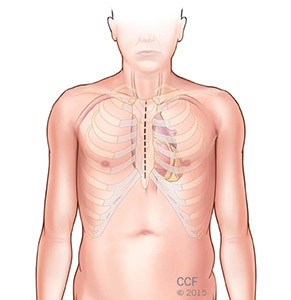Minimally invasive heart surgery
Minimally invasive heart surgery (also called keyhole surgery) is when a conventional operation is performed on or inside the heart using small incisions. The surgeon also sometimes uses specialized instruments.
Benefits of minimally invasive surgery
The benefits of minimally invasive surgery include:
- Small incisions.
- Small scars.
Most patients also have
- Less pain.
- Shorter hospital stay after surgery.
- Lower risk of infection.
- Lower risk of bleeding and blood transfusion.
- Shorter recovery time and faster return to normal activities/work.
Who is a candidate for minimally invasive or robotic surgery?
There are many ways to reach the heart for surgery. Surgeons at Cleveland Clinic always try to use the smallest incision to provide the safest and most successful surgery. Your surgical team will carefully compare the advantages and disadvantages of minimally invasive techniques with those of traditional surgery techniques. Your surgeon will decide the best approach for you based on several factors, including the type or heart disease you have and how severe it is; your age, medical history and lifestyle; and results of tests done before surgery.
Traditional Heart Surgery

Traditional heart surgery uses an incision through the middle of your chest, through the breast bone. The incision is about 6 to 8 inches long.
This is the safest and most commonly used incision for patients who need complicated heart surgeries, reoperations, multiple coronary artery bypass procedures or complex aorta procedures.
Types of minimally invasive heart surgeries
Cleveland Clinic surgeons have performed minimally invasive heart surgery since the mid-1990s. The first surgeries of this type were mitral and aortic valve surgeries. Now, a wide range of procedures can be done using minimally invasive techniques to help make recovery faster and more comfortable.
Sometimes, minimally invasive surgery includes a partial sternotomy. This involves cutting through part of the breast bone. When possible, the surgeon can avoid cutting the breast bone and, instead, make one or more small incisions through the muscles between the ribs. This technique is called a mini-thoracotomy.
Types of incisions used in minimally invasive heart surgery
Partial Sternotomy – through part of the breast bone
A 3 to 4-inch-long incision is made through the sternum, and the breast bone is separated in the area so the surgeon can see the part of the heart that needs surgery.

Mini-thoracotomy
The surgeon avoids cutting through the breastbone and, instead, cuts into muscles between the ribs to reach the heart.

Robotically assisted heart surgery
Most types of robotically assisted heart surgery are used to treat patients with mitral regurgitation (leaky mitral valve). Robotically assisted heart surgery can be used for:
- Mitral valve repair.
- Tricuspid valve repair.
- Coronary artery bypass surgery.
- Ablation of atrial fibrillation.
- Atrial septal defect (ASD) repair.
- Patent foramen ovale (PFO) repair.
- Removal of cardiac tumors (myxoma).
- Lead placement.
Robotically assisted heart surgery incisions

Robotically assisted heart surgery is performed through a small working incision and three other small incisions (ports) made in the spaces between the ribs. The surgical instruments are attached to the robotic arms. The instruments and a tiny camera are placed through the ports. Motion sensors are attached to the robotic “wrist,” so the surgeon can control the instruments.
Robotically assisted mitral valve surgery is performed using only the small port incisions.
Coronary artery bypass surgery may be done using a minimally invasive incision in the space between the ribs as well as the ports. Depending on the technique the surgeon uses, the procedure may be performed on a “beating heart.” This means the heart-lung bypass machine is not used. This is called “off-pump” surgery.
Recovery
If you have minimally invasive or robotic surgery, you will probably be able to go home 2 to 5 days after surgery. Your healthcare team will follow you closely while you are in the hospital and help you recover as quickly as possible.
When you are ready to leave the hospital, you will get instructions on your recovery and return to work, including guidelines for activity, driving, incision care and diet.
In general, it takes about 1 to 4 weeks before you will feel well enough to return to work (if your job doesn’t involve physical activity), resume driving and take part in most nonstrenuous activities, so long as you have stopped taking pain medications. You can usually get entirely back to your normal routine in 5 to 8 weeks after surgery. It is important to know everyone has a different recovery and your healthcare team will give you guidelines based on how well you are doing.
Healthy living
To keep your heart healthy after surgery, it is important to make lifestyle changes and take your medications as prescribed. Heart-healthy lifestyle changes important to your recovery include:
- Quitting smoking.
- Controlling high cholesterol.
- Managing high blood pressure and diabetes.
- Exercising regularly.
- Maintaining a healthy weight.
- Eating a heart-healthy diet.
- Taking part in a cardiac rehabilitation program, as recommended.
- Following up with your doctor for regular visits.